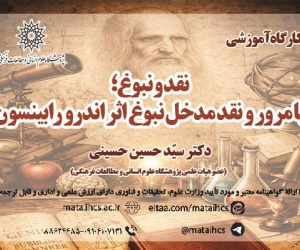پیام رسانی بدنی در مقتل فدایی مازندرانی (مقاله علمی وزارت علوم)
درجه علمی: نشریه علمی (وزارت علوم)
آرشیو
چکیده
پیام رسانی بدنی در مقتل فدایی مازندرانی جمشید داس زرین* نرگس اسکویی ** حسین داداشی*** مقتل نویسی، مقتل سرایی و مقتل خوانی، یکی از مظاهر و بازتاب های ایدئولوژی شیعی در تاریخ نگاری، ادبیات و هنرهای تجسّمی و نمایشی ایرانی- اسلامی است. مقتل سرایی فارسی، نمایشی از خالصانه ترین عواطف غنایی آدمی در مرثیت است که در کالبد زبان و تصاویر این گونه ی شعری گنجانده می شود؛ اما گاهی لبریزی عاطفی، از گنجایی کلامی فراتر می رود و در چنین هنگامی است که عناصر غیرکلامی و پیام های بدنی نیز به یاری زبان فراخوانده می شود. مسئله ی مقاله ی حاضر، تبیین نقش عناصر ارتباطیِ بدنی در مقتل میرزامحمود فدایی مازندرانی، به عنوان یکی از غنایی ترین و طولانی ترین مقاتل منظوم فارسی است. این تحقیق، با روش تحقیق ترکیبی (توصیفی- تحلیلی- آماری) انجام شد و این نتایج به دست آمد: در هشتاد درصد مواقع، پیوند بین عناصر کلامی و غیرکلامی از نوع جانشینی است که نشان از اهمیت و گستره ی پیام رسانی بدنی در مقتل فدایی مازندرانی دارد. نشانه ها و پیام های بدنی در مقتل فدایی در خدمت ساختار روایی و دراماتیک این متن است و در جایگاه عناصر روایی و نمایشی مختلف (فضاسازی، کنش مندی شخصیت ها، توصیفات روایی، گره افکنی و گسترش طرح و پیرنگ) ایفای نقش می کند. این نشانه ها بار غنایی- عاطفی جنبه ی رثایی این مقتل را بسیار تقویت می کنند و در حسی تر شدن مفاهیم و جان بخشی به تصاویر بسیار مؤثرند. کارکرد مهم دیگر پیام رسانی بدنی در این اثر، کمک به انتقال و تقویت گفتمان عاشورایی و منظورهای اعلامی و تبلیغی مهم این گفتمان ایدئولوژیکی است. * دانشجوی دکتری زبان و ادبیات فارسی واحد بناب، دانشگاه آزاد اسلامی، بناب، ایران zarrin_1350@yahoo.com **دانشیار زبان و ادبیات فارسی، واحد بناب، دانشگاه آزاد اسلامی، بناب، ایران noskooi@yahoo.com(نویسنده ی مسئول) *** استادیار زبان و ادبیات فارسی، واحد بناب، دانشگاه آزاد اسلامی، بناب، ایران hossein.dadashi53@yahoo.com تاریخ دریافت مقاله: 17/12/1400 تاریخ پذیرش مقاله: 5/4/1401Physical Messaging in the Maqtal of Fadaei Mazandarani
Jamshid DasZarrin PhD Student, Department of Persian Language and Literature, Bonab Branch, Islamic Azad University, Bonab, Iran. Narges Oskooi )ResponsibleAuthor) Associate Professor, Department of Persian Language and Literature, Bonab Branch, Islamic Azad University, Bonab, Iran. Hossein Dadashi Assistant Professor of Persian Language and Literature, Islamic Azad University, Bonab, Iran. Introduction According to historiographical expressions, Maqtal (place of killing or murder) refers to the description of reasons, motivations, peripheral events, details, contemporaneous accidents and the consequences of killing someone or some ones specific which has been the origin of evolution in different intellectual, political, cultural, military or social dimensions during a period of time; the first writing of Maqtal in Islamic historiography dates back to Ashura event and the Shia history: “the first examples of Maqtals are oral ones about the murder of Osman, but it was Iraqi Shiites who wrote Osman Maqtal, so it seems that Sunni Maqtal-writers are more influenced by the Shiites and wrote Osman Maqtal against them” (Hosseinian Moghaddam, 2016: 89). The Shiites’ inclination to the third Imam and Hosseini epic has developed Maqtal to art and literature, so that “bloody altars and Seyyedoshohada place of murder have been the subject of valid Maqtals” (Anasori, 2004: 95). The Maqtal of poor Mirza Mahmood Fadaei Mazandarani the Persian-speaking elegist poet in 13th lunar century and contemporaneous with Fath-Ali Shah Qajar and Mohammad Shah Qajar has been recorded as one of entries of the Encyclopedia of Islam. With 3718 verses, this Maqtal is considered the longest Persian Tarkib-Band (Composite-Tie) with four “systems” or “parts”, so it is sometimes called “Fadaei’s Four-System’. Research Objectives & Significance Considering emotional language and great and living pictures, Fadaei’s Maqtal is one of the richest examples of this type of Persian poem. It is obvious that linguistic elements have not been able to carry such great volume of lyrical themes and emotional connotation existing in this Maqtal. This shows the necessity of doing research in non-verbal processes existing in this work; therefore, searching for the aforementioned questions, the current study aims at the following objectives: Analyzing the role of physical communications in making more emotional and more influencing text narrative and elegiac dimensions. Explaining and highlighting the role of non-verbal communications in transferring Ashurai discourse of this Maqtal. Research literature Several studies have introduced and investigated the style of Fadaei’s Maqtal-writing and analyzed stylistic features of elegy: Taheri Shahab (1961) in “Fadaei Telavaki Mazandarani”, Fereydoon Akbari Sheldareh in several article such as “Involution and Evolution in Fadaei Mazandarani’s Poetry”, “Fadaei Mazandarani the Reporter of Hosseini Epic” and “Aesthetic Investigation of Fadaei Mazandarani’s Ashurai Poems” with his colleagues, Mohseni et al. (2015) have introduced the frequency of Arabic words and the art of structures like repetition, allusion, long Radifs and also different rhetoric simile metaphorical pictures as the most frequent literary and artistic aspects of this work in “Investigating the Stylistics of the Maqtal of Poor Fadaei Mazandarani”. Investigating Physical Messaging in Fadaei Mazandarani Maqtal - Body Language and Narrative and Dramatic Grammar Due to lyrical and dramatic nature of this literary genre, searching for the role of non-verbal communications in recognizing narrative grammar of Maqtals in investigating narrative structure of them will significantly help understanding narrative system of this poetic genre; the role of so many narrative and dramatic elements like space creation, descriptions, complication, functions and current processes and the development of narration plot is played by messages resulted from body movements; the important point is t









